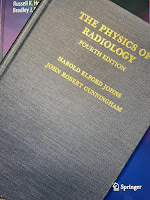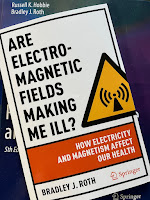 |
| The Physics of Radiology, by Johns and Cunningham. |
In True Tales, Jacob Van Dyk wrote
In 1971, I was hired by Professor Harold Elford Johns to work as a medical physicist at the Princess Margaret Hospital (PMH) in Toronto. Professor Jack Cunningham was my immediate boss. Professor Johns was considered the guru of Medical Physics with a world-renowned reputation for being a great scientist, a feared graduate student supervisor, and humanitarian. Over the years, he received multiple awards including five honorary doctorate degrees, and Officer of the Order of Canada. He was the first medical physicist to be inducted into the Canadian Medical Hall of Fame. Jack Cunningham also received the Officer of the Order of Canada along with multiple other awards, largely for his work on software development for computerized radiation treatment planning systems. Johns and Cunningham were the authors of The Physics of Radiology, the textbook which gave me my medical physics grounding as it did for all other young, aspiring medical physicists at that time….In his chapter of True Tales, Terry Peters wrote
[When Van Dyk was studying for his medical physics certification exams], Professors Johns and Cunningham were working on a draft of the fourth edition of their book, The Physics of Radiology. In January, I asked Jack Cunningham if I could review the available draft of this fourth edition. Considering that they would be contributors to the certification examination questions, my guess was that some, if not all, of the questions could be answered if I knew everything in this new edition. So, I went through this draft of the book from cover to cover and I solved (at least I worked on) every problem that was posed at the end of each chapter. As part of this process, I provided Jack with some comments on some questionable things that I found in the draft. As a result, my name was listed, along with others, in the acknowledgments when the book was published in 1983.
During my early years at McGill, I became involved in the activities of the newly formed Canadian College of Physicists in Medicine (CCPM), which had begun the process of credentialling Medical Physicists in Canada. While I had Engineering, rather than Physics, training, I felt that my background had prepared me well for the roles I was playing in Diagnostic Radiology at the Neuro. Nevertheless, I felt it would do no harm to formally study radiation physics and its practical implementation in medicine, so in 1983 I embarked on a mission to devour The Physics of Radiology, by Johns and Cunningham, in preparation for the CCPM Fellowship exams in 1984. The examination process had evolved into an oral session, and a closed book examination—where three questions were selected from a previously published catalogue of questions covering all aspects of Medical Physics. Every Friday afternoon for almost a year I studied “Johns and Cunningham” with Gino Fallone, then a physicist at the Montreal General Hospital, who had also decided to take the certification examination. A gruelling process, but finally successful—we both became CCPM fellows that year.Martin Yaffe's contribution to True Tales described a bit about Johns background and career.
Dr. Johns had been born in Chengdu, China to Canadian church missionary parents and he had spent his early years there, roaming about small communities in the mountains of Szechuan province with his father, a no-nonsense disciplinarian who believed strongly in devotion to duty and hard work. He learned to be focussed and driven to succeed at whatever was his mission. When the family eventually returned to Canada, he brought that to his graduate work in physics and later to the University of Saskatchewan where he built a strong medical physics research group, concentrating on developing and refining radiation therapy. There he developed the first (or possibly the second—there is some debate as his unit and a competitor, built by Eldorado Mining and Refining Ltd., were used to treat patients within a week or two of each other) cobalt-60 radiation treatment system and carried out pioneering work on radiation dosimetry and treatment planning. Dr. Johns and his work in Saskatchewan were actually mentioned in the film First Man, about the astronaut Neil Armstrong whose daughter had suffered from a brain tumour. Later, he began work on The Physics of Radiology, a textbook which he referred to jokingly (I think) as “The Bible”. This book truly became a guide to those working in radiation oncology all over the world and was published in multiple languages. While the book and its various editions consumed many of his evenings after a hard day at the lab, Johns reverse bragged that he earned about two cents per hour on his textbook writing efforts.
I once estimated that I make about ten cents an hour for my work on IPMB. I guess the difference represents inflation.
Yaffe also reminisced on Johns’ personality and mentoring technique.
Johns had an abrupt nature, not hesitating to poke you emphatically when he felt that you needed to think harder. Often, he would read your carefully written document, hold it up between you and slowly rip it to shreds before filing it in the trash bin. If it was late in the day, he would tell you to meet him the next morning at eight to re-write.The Physics of Radiology is one of those landmark textbooks (like Jackson’s Classical Electrodynamics in physics) that is a rite of passage for a student in that a field of study. As a coauthor on IPMB, I know what an honor it would be for your book to make that sort of impact. Johns and Cunningham was cited in the second edition of IPMB, but not in earlier or later editions.
What I learned in those sessions was how to sharply focus your thinking on a problem and how to persist until you had a workable solution. Dr. Johns had two more senior students at the time—Aaron Fenster… and Don Plewes. These two and the lab technician, Dan Ostler, more or less adopted me and provided mentoring to prepare me for my sessions with Johns. Also, Johns used to invite me into his office when he was working on a paper with Aaron or Don and let me watch. While he was more respectful toward them, it was not uncommon for him to fix one of them with his laser-like glare which he held on them for what seemed like minutes and then say something like: “Plews” (he never pronounced the “e” that made it rhyme with Lewis; instead he made it rhyme with “news”), “If you sent that to a journal, they’d crap all over you”. Or, as he slowly ripped up a piece of writing that Aaron had proudly submitted, he’d say at a similar slow pace, “well (rrrrip) Fenster (rrrrip), your (rrrrip) writing (rrrrip) is improving.” So, rather than feel discriminated against, I simply realized that the standards were high, and I’d have to present my best game at all times.
The fourth edition is the last that Johns and Cunningham published. However, just last year an updated fifth edition was prepared by a team of five authors.











